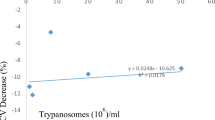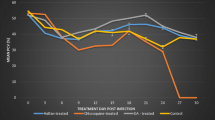Abstract
In a preliminary study, using clonogenic assays, the in vitro kinetics of committed haemopoietic progenitors were monitored during a Trypanosoma congolense rechallenge infection in five trypanosusceptible Boran cattle. Early in the infection (week 2), in the absence of any detectable parasitaemia, a drop in the number of nucleated marrow cells was recorded. This was accompanied by a marked but transient decrease in the levels of the colony-forming units-erythroid (CFU-E) followed by a partial recovery by weeks 3–4 after infection. The burst-forming units-erythroid (BFU-E) and the colony-forming units-granulocyte macrophage (CFU-GM) also significantly decreased between weeks 2 and 4. After a transient rise at weeks 3–5 postinfection, the CFU-GM steadily declined and remained below preinfection levels throughout the infection. The BFU-E remained below preinfection levels until the end of the experiment. The drop in nucleated marrow cells associated with the decreased numbers of CFU-E, BFU-E and CFU-GM was suggestive of a defect at the pluripotential stem cell level early in the infection (week 2). The erythrocyte indices, i.e. mean corpuscular volume (MCV) and mean corpuscular haemoglobin concentration (MCHC), were unchanged until week 10 postinfection. Two animals became severely anaemic; one was euthanised at week 8 and one treated at week 9. The three remaining animals developed chronic anaemia with mean packed cell volume (PCV) fluctuating around 18%–19% between weeks 11 and 14. Low parasitaemia levels were recorded during that period. A CFU-E peak above preinfection levels was noted at week 12 and BFU-E appeared in the peripheral blood culture of two animals between weeks 11 and 14. A progressive rise in MCV associated with a gradual decrease in MCHC also characterised that period. A return to near preinfection levels was recorded for the numbers of all three progenitors three weeks after trypanocidal treatment followed by a full recovery five months after treatment. Although ineffective haemopoiesis has been suggested to contribute to the anaemia of bovine trypanosomiasis, this is the first demonstration of a negative effect on erythroid development in cultures of bone marrow of trypanosome-infected cattle.
Similar content being viewed by others
References
Anosa VO (1988) Haematological and biochemical changes in human and animal trypanosomosis. Part I. Rev Elev Med Vet Pays Trop 41:65–78
Anosa VO, Logan-Henfrey LL, Shaw MK (1992) A light and electron microscopic study of changes in blood and bone marrow in acute hemorrhagic Trypanosoma vivax infection in calves. Vet Pathol 29:33–45
Dargie JD (1980) Pathophysiology of trypanosomiasis in the bovine. In: Isotope and radiation research on animal diseases and their vectors. International Atomic Energy Agency, Vienna (IAEA-SM240/28), pp. 121–131
Dargie JD, Murray PK, Murray M et al. (1979) Bovine trypanosomiasis: the red cell kinetics of N'Dama and Zebu cattle infected with Trypanosoma congolense. Parasitology 78:271–286
Faquin WC, Schneider TJ, Goldberg MA (1992) Effect of inflammatory cytokines on hypoxia-induced erythropoietin production. Blood 79:1987–1994
Ferrero D, Broxmeyer HE, Pagliardi GL et al. (1983)Antigenically distinct subpopulations of myeloid progenitor cells (CFU-GM) in human peripheral blood and marrow. Proc Natl Acad Sci USA 80:4114–4118
Fiennes RN (1970) Pathogenesis and pathology of animal trypanosomiases. In: Mulligan HW (ed) The African Trypanosomiases. George Allen & Unwin, London, pp 729–750
Fritsch G, Nelson RT (1990) Bovine erythroid (CFU-E, BFU-E)and granulocyte-macrophage colony formation in culture. Exp Hematol 18:195–200
Igbokwe IO (1989) Dyserythropoiesis in animal trypanosomosis. Rev Elev Med Vet Pays Trop 42:423–429
Igbokwe IO, Mohammed A (1991) The reticulocyte response to the anaemia in goats caused by experimental Trypanosoma brucei infection. Vet Res Commun 15:373–377
Jain NC (1986a) Hematologic techniques. In: Schalm's Veterinary Hematology, 4th edn. Lea and Febiger, Philadelphia, pp 20–86
Jain NC (1986b) Cattle:normal hematology with comments on response to disease. In: Schalm's Veterinary Hematology, 4th edn. Lea and Febiger, Philadelphia, pp 178–207
Kaaya GP, Tizard IR, Maxie MG et al. (1980) Inhibition of leukopoiesis by sera from Trypanosoma congolense infected calves: partial characterization of the inhibitory factor. Tropenmed Parasitol 31:232–238
Kaaya GP, Valli VEO, Maxie MG et al. (1979) Inhibition of bovine bone marrow granulocyte/macrophage colony formation in vitro by serum collected from cattle infected with Trypanosoma vivax or Trypanosoma congolense. Tropenmed Parasitol 30:230–235
Lawson BM, Valli VEO, Mills JN et al. (1980) The quantitation of Trypanosoma congolense in calves. IV. In vitro culture of myeloid and erythroid marrow cells. Tropenmed Parasitol 31:425–434
Maggio-Price L, Brookoff D, Weiss L (1985) Changes in haematopoietic stem cells in bone marrow of mice with Plasmodium berghei malaria. Blood 66:1080–1085
Means RTJr, Krantz SB (1991) Inhibition of human erythroid colonyforming units by y interferon can be corrected by recombinant human erythropoietin. Blood 78:2564–2567
Miller KL, Silverman PH, Kullgren B et al. (1989) Tumor necrosis factor alpha and the anaemia associated with murine malaria. Infect Immun 57:1542–1546
Murray M, Dexter TM (1988) Anaemia in bovine African trypanosomiasis. Acta Trop 45:389–432
Murray M, McIntyre WIM, Murray PK et al. (1977) Cattle diseases and trypanosomiasis in the Gambia. II. Pathology studies. In: International Scientific Council for Trypanosomiasis Research and Control, 15th Meeting, Banjul, The Gambia. OAU/STRC (Publication No 110), Nairobi, Kenya, pp 92–98
Murray M, Morrison WI, Emery DL et al. (1980) Pathogenesis of trypanosome infections in cattle. In: Isotope and radiation research on animal diseases and their vectors. International Atomic Energy Agency, Vienna (IAEA-SM-240/19), pp 15–32
Naylor PF, Little TWA (1975) A simple method for isolating leucocytes from bovine blood and their separation into lymphocyte and granulocyte fractions. Res Vet Sci 18:336–337
Ogawa M, Grush OC, O'Dell RF et al. (1977) Circulating erythropoietic precursors assessed in culture: characterization in normal men and patients with hemoglobinopathies. Blood 50:1081–1092
Paling RW, Moloo SK, Scott JR et al. (1991) Susceptibility of N'Dama and Boran cattle to tsetse-transmitted primary and rechallenge infections with a homologous serodeme of Trypanosoma congolense. Parasite immunol 13:413–425
Paris J, Murray M, McOdimba F (1982) A comparative evaluation of the parasitological techniques currently available for the diagnosis of African trypanosomiasis in cattle. Acta Trop 39:307–316
Silverman PH, Schooley JC, Mahlmann LJ (1987) Marine malaria decreases hemopoietic stem cells. Blood 69:408–413
Suliman HB, Feldman BF (1989) Pathogenesis and aetiology of anaemia in trypanosomiasis with special reference to T. brucei and T. evansi. Vet Bull 59:99–107
Valli VEO, Forsberg CM, McSherry BJ (1978) The pathogenesis of Trypanosoma congolense infection in calves. II. Anemia and erythroid response. Vet Pathol 15:732–745
Valli VEO, Mills JN (1980) The quantitation of Trypanosoma congolense in calves. I. Hematological changes. Tropenmed Parasitol 31:215–231
Wellde BT, Preston JM, Kovatch RM, et al. (1989) Trypanosoma congolense: erythrocyte indices, plasma iron turnover and effects of treatment in infected cattle. Ann Trop Med Parasitol 83:201–206
Williams DJL, Naessens J, Scott JR et al. (1991) Analysis of peripheral leucocyte populations in N'Dama and Boran cattle following a rechallenge infection with Trypanosoma congolense. Parasite Immunol 13:171–185
Winer BJ (1971) Statistical principles in experimental design, 2nd edn, McGraw-Hill, New York, 907.
Author information
Authors and Affiliations
Rights and permissions
About this article
Cite this article
Andrianarivo, A.G., Muiya, P., McOdimba, F.A. et al. Kinetics of haemopoietic progenitor cells during a Trypanosoma congolense rechallenge infection in Boran cattle. Comp Haematol Int 4, 1–10 (1994). https://doi.org/10.1007/BF00368259
Issue Date:
DOI: https://doi.org/10.1007/BF00368259




